Exploring Technological Trends in Logistics: Topic Modeling-Based Patent Analysis
Abstract
:1. Introduction
2. Background
2.1. Technology-Driven Innovation in Logistics
2.2. Patent Analysis for Technology Exploration
2.3. LDA for Topic Analysis
3. Research Methodology
3.1. Step 1: Data Collection
3.2. Step 2: Data Pre-Processing
3.3. Step 3: Topic Identification
3.4. Step 4: Topic Exploration
4. Analysis and Results
4.1. Data and Pre-Processing
Basic Features of Logistics-Related Patents
4.2. Technological Topics in Logistics
4.2.1. Trends in Patenting Activities in Logistics-Related Technology
4.2.2. Major Assignees in Logistics-Related Technology
5. Discussion and Conclusions
5.1. Discussion
5.1.1. Patent Search Policy for Investigating Technological Trends in Logistics
5.1.2. Usefulness of a Tool for Technology Trend Exploration in Logistics
5.1.3. Patent-Based Approach to the Exploration of Technology-Driven Innovation in Logistics
5.1.4. Time Window of Patent Data for Topic Identification and Exploration in Logistics
5.2. Contributions
5.3. Limitations
Author Contributions
Funding
Acknowledgments
Conflicts of Interest
References
- Gunasekaran, A.; Ngai, E.W.T. The successful management of a small logistics company. Int. J. Phys. Distrib. Logist. 2003, 33, 825–842. [Google Scholar] [CrossRef] [Green Version]
- Sandberg, E. Understanding logistics-based competition in retail–a business model approach. Int. J. Retail Distrib. Manag. 2013, 41, 176–188. [Google Scholar] [CrossRef]
- Tracey, M.; Limm, J.S.; Vonderembse, M.A. The impact of supply-chain management capabilities on business performance. Supply Chain Manag. 2005, 10, 179–191. [Google Scholar] [CrossRef]
- Bowersox, D.J. Improving The Logistics Marketing/Sales Interface. In Annual Conference Proceedings of the Council of Logistics Management; Council of Logistics Management: Oak Brook, IL, USA, 1991; pp. 245–255. [Google Scholar]
- Hammant, J. Information technology trends in logistics. Logist. Inf. Manag. 1995, 8, 32–37. [Google Scholar] [CrossRef]
- Renko, S.; Ficko, D. New logistics technologies in improving customer value in retailing service. J. Retail. Consum. Serv. 2010, 17, 216–223. [Google Scholar] [CrossRef]
- Bourlakis, M.; Bourlakis, C. Integrating logistics and information technology strategies for sustainable competitive advantage. J. Enterp. Inf. Manag. 2006, 19, 389–402. [Google Scholar] [CrossRef]
- Brah, S.A.; Lim, H. The effects of technology and TQM on the performance of logistics companies. Int. J. Phys. Distrib. Logist. 2006, 36, 192–209. [Google Scholar] [CrossRef]
- Harris, I.; Wang, Y.; Wang, H. ICT in multimodal transport and technological trends: Unleashing potential for the future. Int. J. Prod. Econ. 2015, 159, 88–103. [Google Scholar] [CrossRef]
- Yu, Y.; Wang, X.; Zhong, R.Y.; Huang, G.Q. E-commerce logistics in supply chain management: Practice perspective. Procedia Cirp 2016, 52, 179–185. [Google Scholar] [CrossRef]
- Zhu, X.; Mukhopadhyay, S.K.; Kurata, H. A review of RFID technology and its managerial applications in different industries. J. Eng. Technol. Manag. 2012, 29, 152–167. [Google Scholar] [CrossRef]
- Fera, M.; Macchiaroli, R.; Fruggiero, F.; Lambiase, A.; Miranda, S. Application of a business process model (BPM) method for a warehouse RFId system implementation. Int. J. Technol. 2017, 8, 57–77. [Google Scholar] [CrossRef]
- Agrahri, H.; Ahmed, F.; Verma, V.K.; Purohit, J.K. Benefits of implement big data driven supply chain management: An ISM based model. Int. J. Eng. Sci. 2017, 7, 11426–11431. [Google Scholar]
- Fera, M.; Fruggiero, F.; Lambiase, A.; Macchiaroli, R.; Miranda, S. The role of uncertainty in supply chains under dynamic modeling. Int. J. Ind. Eng. Comput. 2017, 8, 119–140. [Google Scholar] [CrossRef]
- Alshawi, S. Logistics in the Internet age: Towards a holistic information and processes picture. Logist. Inf. Manag. 2001, 14, 235–242. [Google Scholar] [CrossRef]
- Chapman, R.L.; Soosay, C.; Kandampully, J. Innovation in logistic services and the new business model: A conceptual framework. Manag. Serv. Qual. Int. J. 2002, 12, 358–371. [Google Scholar] [CrossRef]
- Drabik, P.; Zamecnik, P. Key Aspects of Logistics for Online Store and Multichannel Distribution. In Proceedings of the 16th International Joint Conference: Central and Eastern Europe in the Changing Business Environment, Prague, Czech Republic, 27 May 2016; pp. 97–111. [Google Scholar]
- Hofmann, E.; Osterwalder, F. Third-party logistics providers in the digital age: Towards a new competitive arena? Logistics 2017, 1, 9. [Google Scholar] [CrossRef]
- Olavarrieta, S.; Ellinger, A.E. Resource-based theory and strategic logistics research. Int. J. Phys. Distrib. Logist. 1997, 27, 559–587. [Google Scholar] [CrossRef]
- Auramo, J.; Aminoff, A.; Punakivi, M. Research agenda for e-business logistics based on professional opinions. Int. J. Phys. Distrib. Logist. 2002, 32, 513–531. [Google Scholar] [CrossRef]
- Srinivasan, R.; Lilien, G.L.; Rangaswamy, A. Technological opportunism and radical technology adoption: An application to e-business. J. Mark. 2002, 66, 47–60. [Google Scholar] [CrossRef]
- Gerken, J.M.; Moehrle, M.G. A new instrument for technology monitoring: Novelty in patents measured by semantic patent analysis. Scientometrics 2012, 91, 645–670. [Google Scholar] [CrossRef]
- Teichert, T.; Mittermayer, M.A. Text Mining for Technology Monitoring. In Proceedings of the International Engineering Management Conference, Cambridge, UK, 18–20 August 2002; Volume 2, pp. 596–601. [Google Scholar]
- Basberg, B.L. Patent statistics and the measurement of technological change—An assessment of the Norwegian patent data, 1840–1980. World Patent Inf. 1984, 6, 158–164. [Google Scholar] [CrossRef]
- Lichtenthaler, E. Technological change and the technology intelligence process: A case study. J. Eng. Technol. Manag. 2004, 21, 331–348. [Google Scholar] [CrossRef]
- Porter, A.L.; Cunningham, S.W. Tech Mining: Exploiting New Technologies for Competitive Advantage; John Wiley & Sons, Inc.: Hoboken, NJ, USA, 2005. [Google Scholar]
- Kerr, C.I.; Mortara, L.; Phaal, R.; Probert, D.R. A conceptual model for technology intelligence. Int. J. Technol. Intell. Plan. 2006, 2, 73–93. [Google Scholar] [CrossRef]
- Hashimi, H.; Hafez, A.; Mathkour, H. Selection criteria for text mining approaches. Comput. Hum. Behav. 2015, 51, 729–733. [Google Scholar] [CrossRef]
- United States Patent and Trademark Office. General Information Concerning Patents. 2015. Available online: https://www.uspto.gov/patents-getting-started/general-information-concerning-patents (accessed on 7 March 2018).
- Basberg, B.L. Patents and the measurement of technological change: A survey of the literature. Res. Policy 1987, 16, 131–141. [Google Scholar] [CrossRef]
- Daim, T.U.; Rueda, G.; Martin, H.; Gerdsri, P. Forecasting emerging technologies: Use of bibliometrics and patent analysis. Technol. Forecast. Soc. 2006, 73, 981–1012. [Google Scholar] [CrossRef]
- Porter, A.L.; Detampel, M.J. Technology opportunities analysis. Technol. Forecast. Soc. 1995, 49, 237–255. [Google Scholar] [CrossRef]
- Lee, C.; Park, H.; Park, Y. Keeping abreast of technology-driven business model evolution: A dynamic patent analysis approach. Technol. Anal. Strateg. 2013, 25, 487–505. [Google Scholar] [CrossRef]
- Lee, W.S.; Sohn, S.Y. Identifying Emerging Trends of Financial Business Method Patents. Sustainability 2017, 9, 1670. [Google Scholar] [Green Version]
- Ellram, L.M.; La Londe, B.J.; Weber, M.M. Retail logistics. Int. J. Phys. Distrib. Logist. 1999, 29, 477–494. [Google Scholar] [CrossRef]
- Kache, F.; Seuring, S. Challenges and opportunities of digital information at the intersection of big data analytics and supply chain management. Int. J. Oper. Prod. Manag. 2017, 37, 10–36. [Google Scholar] [CrossRef]
- Lin, T.H.; Lin, I.C. Factors for information technology acceptance willingness and adoption in logistics industry from supply chain perspectives. Int. J. Electron. Bus. 2014, 12, 167–177. [Google Scholar]
- Ramanathan, R.; Ramanathan, U.; Ko, L.W.L. Adoption of RFID technologies in UK logistics: Moderating roles of size, barcode experience and government support. Expert Syst. Appl. 2014, 41, 230–236. [Google Scholar] [CrossRef] [Green Version]
- Evangelista, P.; Mogre, R.; Perego, A.; Raspagliesi, A.; Sweeney, E. A survey based analysis of IT adoption and 3PLs’ performance. Supply Chain. Manag. 2012, 17, 172–186. [Google Scholar] [CrossRef]
- Wu, Y.-C.J. Assessment of technological innovations in patenting for 3rd party logistics providers. J. Enterp. Inf. Manag. 2006, 19, 504–524. [Google Scholar]
- Kandampully, J. Innovation as the core competency of a service organisation: The role of technology, knowledge and networks. Eur. J. Innov. Manag. 2002, 5, 18–26. [Google Scholar] [CrossRef]
- Closs, D.J.; Goldsby, T.J.; Clinton, S.R. Information technology influences on world class logistics capability. Int. J. Phys. Distrib. Logist. 1997, 27, 4–17. [Google Scholar] [CrossRef]
- Flint, D.J.; Larsson, E.; Gammelgaard, B.; Mentzer, J.T. Logistics innovation: A customer value-oriented social process. J. Bus. Logist. 2005, 26, 113–147. [Google Scholar] [CrossRef]
- Kerr, A. Information technology–creating strategic opportunities for logistics. Int. J. Phys. Distrib. 1989, 19, 15–17. [Google Scholar] [CrossRef]
- Stock, J.R. Managing computer, communication and information technology. Logist. Transp. Rev. 1990, 26, 133. [Google Scholar]
- Bowersox, D.J.; Closs, D.J. Logistical Management: The Integrate Supply Chain Management; McGraw-Hill: London, UK, 1996; pp. 63–70. [Google Scholar]
- Lewis, I.; Talalayevsky, A. Third-party logistics: Leveraging information technology. J. Bus. Logist. 2000, 21, 173–186. [Google Scholar]
- Delfmann, W.; Albers, S.; Gehring, M. The impact of electronic commerce on logistics service providers. Int. J. Phys. Distrib. Logist. 2002, 32, 203–222. [Google Scholar] [CrossRef]
- Lazaris, C.; Vrechopoulos, A. From Multi-Channel to “Omnichannel” Retailing: Review of the Literature and Calls for Research. In Proceedings of the 2nd International Conference on Contemporary Marketing Issues, Athens, Greece, 18–20 June 2014; pp. 18–20. [Google Scholar]
- Koh, S.L.; Gunasekaran, A.A. knowledge management approach for managing uncertainty in manufacturing. Ind. Manag. Data Syst. 2006, 106, 439–459. [Google Scholar] [CrossRef]
- Chow, H.K.; Choy, K.L.; Lee, W.B.; Chan, F.T. Integration of web-based and RFID technology in visualizing logistics operations—A case study. Supply Chain Manag. 2017, 12, 221–234. [Google Scholar] [CrossRef]
- Lai, F.; Li, D.; Wang, Q.; Zhao, X. The information technology capability of third-party logistics providers: A resource-based view and empirical evidence from China. J. Supply Chain Manag. 2008, 44, 22–38. [Google Scholar] [CrossRef]
- Pokharel, S. Perception on information and communication technology perspectives in logistics: A study of transportation and warehouses sectors in Singapore. J. Enterp. Inf. Manag. 2005, 18, 136–149. [Google Scholar] [CrossRef]
- Giaglis, G.M.; Minis, I.; Tatarakis, A.; Zeimpekis, V. Minimizing logistics risk through real-time vehicle routing and mobile technologies: Research to date and future trends. Int. J. Phys. Distrib. Logist. 2004, 34, 749–764. [Google Scholar] [CrossRef]
- Oláh, J.; Karmazin, G.; Pető, K.; Popp, J. Information technology developments of logistics service providers in Hungary. Int. J. Logist. Res. Appl. 2018, 21, 332–344. [Google Scholar] [CrossRef]
- Wang, Q.; Lai, F.; Zhao, X. The impact of information technology on the financial performance of third-party logistics firms in China. Supply Chain Manag. 2008, 13, 138–150. [Google Scholar] [CrossRef]
- Wu, F.; Yeniyurt, S.; Kim, D.; Cavusgil, S.T. The impact of information technology on supply chain capabilities and firm performance: A resource-based view. Ind. Mark. Manag. 2006, 35, 493–504. [Google Scholar] [CrossRef]
- Colla, E.; Dupuis, M. Research and managerial issues on global retail competition: Carrefour/Wal-Mart. Int. J. Retail Distrib. Manag. 2002, 30, 103–111. [Google Scholar] [CrossRef]
- Vowels, S.A. A strategic case for RFID: An examination of Wal-Mart and its supply chain. In Proceedings of the Ninth Annual Conference of the Southern Association for Information Systems, Jacksonville, FL, USA, 8–9 December 2006; pp. 148–152. [Google Scholar]
- Kim, C.; Yang, K.H.; Kim, J. A strategy for third-party logistics systems: A case analysis using the blue ocean strategy. Omega 2008, 36, 522–534. [Google Scholar] [CrossRef]
- Lieb, R.C.; Lieb, K.J. Is Amazon a 3PL. Supply Chain Quarterly. Quarter 3 2014. Available online: http://www.supplychainquarterly.com/topics/Logistics/20141027-is-amazon-a-3pl/ (accessed on 26 July 2018).
- Busse, C. A procedure for secondary data analysis: Innovation by logistics service providers. J. Supply Chain Manag. 2010, 46, 44–58. [Google Scholar] [CrossRef]
- Ling, T.K.; Lee, C.K.; Ho, W. The analysis and case studies of successful express logistics companies. Int. J. Value Chain Manag. 2009, 3, 20–35. [Google Scholar] [CrossRef]
- Stock, J.R. Doctoral Research in logistics and logistics-related areas: 1992–1998. J. Bus. Logist. 2001, 22, 125–256. [Google Scholar] [CrossRef]
- Tseng, Y.H.; Lin, C.J.; Lin, Y.I. Text mining techniques for patent analysis. Inf. Process. Manag. 2007, 43, 1216–1247. [Google Scholar] [CrossRef]
- Archibugi, D.; Planta, M. Measuring technological change through patents and innovation surveys. Technovation 1996, 16, 451–519. [Google Scholar] [CrossRef]
- Ernst, H. The use of patent data for technological forecasting: The diffusion of CNC-technology in the machine tool industry. Small Bus. Econ. 1997, 9, 361–381. [Google Scholar] [CrossRef]
- Narin, F. Patent bibliometrics. Scientometrics 1994, 30, 147–155. [Google Scholar] [CrossRef]
- Narin, F.; Noma, E.; Perry, R. Patents as indicators of corporate technological strength. Res. Policy 1987, 16, 143–155. [Google Scholar] [CrossRef]
- Lei, X.P.; Zhao, Z.Y.; Zhang, X.; Chen, D.Z.; Huang, M.H.; Zheng, J.; Liu, R.S.; Zhang, J.; Zhao, Y.H. Technological collaboration patterns in solar cell industry based on patent inventors and assignees analysis. Scientometrics 2013, 96, 427–441. [Google Scholar] [CrossRef]
- Choi, J.Y.; Jeong, S.; Kim, K. A study on diffusion pattern of technology convergence: Patent analysis for Korea. Sustainability 2015, 7, 11546–11569. [Google Scholar] [CrossRef]
- Yun, J.J.; Jeong, E.; Park, J. Network analysis of open innovation. Sustainability 2016, 8, 729. [Google Scholar] [CrossRef]
- Cho, T.S.; Shih, H.Y. Patent citation network analysis of core and emerging technologies in Taiwan: 1997–2008. Scientometrics 2011, 89, 795. [Google Scholar] [CrossRef]
- Kim, G.; Lee, J.; Jang, D.; Park, S. Technology clusters exploration for patent portfolio through patent abstract analysis. Sustainability 2016, 8, 1252. [Google Scholar] [CrossRef]
- Yoon, B.; Park, Y. A text-mining-based patent network: Analytical tool for high-technology trend. J. High Technol. Manag. Res. 2004, 15, 37–50. [Google Scholar] [CrossRef]
- Chen, H.; Zhang, G.; Zhu, D.; Lu, J. Topic-based technological forecasting based on patent data: A case study of Australian patents from 2000 to 2014. Technol. Forecast. Soc. 2017, 119, 39–52. [Google Scholar] [CrossRef]
- Jeong, B.; Yoon, J. Competitive intelligence analysis of augmented reality technology using patent information. Sustainability 2017, 9, 497. [Google Scholar] [CrossRef]
- Lee, W.S.; Han, E.J.; Sohn, S.Y. Predicting the pattern of technology convergence using big-data technology on large-scale triadic patents. Technol. Forecast. Soc. 2005, 100, 317–329. [Google Scholar] [CrossRef]
- Kuusi, O.; Meyer, M. Anticipating technological breakthroughs: Using bibliographic coupling to explore the nanotubes paradigm. Scientometrics 2007, 70, 759–777. [Google Scholar] [CrossRef]
- Van Merkerk, R.O.; Van Lente, H. Tracing emerging irreversibilities in emerging technologies: The case of nanotubes. Technol. Forecast. Soc. 2005, 72, 1094–1111. [Google Scholar] [CrossRef]
- Suominen, A.; Toivanen, H.; Seppänen, M. Firms’ knowledge profiles: Mapping patent data with unsupervised learning. Technol. Forecast. Soc. 2017, 115, 131–142. [Google Scholar] [CrossRef]
- Alghamdi, R.; Alfalqi, K. A survey of topic modeling in text mining. Int. J. Adv. Comput. Sci. Appl. 2015, 6, 147–153. [Google Scholar] [CrossRef]
- Blei, D.M. Probabilistic topic models. Commun. ACM 2012, 55, 77–84. [Google Scholar] [CrossRef]
- Blei, D.M.; Ng, A.Y.; Jordan, M.I. Latent dirichlet allocation. J. Mach. Learn. Res. 2003, 3, 993–1022. [Google Scholar]
- Steyvers, M.; Griffiths, T. Probabilistic topic models. In Handbook of Latent Semantic Analysis; Lawrence Erlbaum Associates, Inc.: Mahwah, NJ, USA, 2007; pp. 424–440. [Google Scholar]
- Nigam, K.; McCallum, A.K.; Thrun, S.; Mitchell, T. Text classification from labeled and unlabeled documents using EM. Mach. Learn. 2000, 39, 103–134. [Google Scholar] [CrossRef]
- Grün, B.; Hornik, K. Topicmodels: An R package for fitting topic models. J. Stat. Softw. 2011, 40, 1–30. [Google Scholar] [CrossRef]
- Hofmann, T. Probabilistic Latent Semantic Indexing. In ACM SIGIR Forum; ACM: New York, NY, USA, 2017; Volume 51, pp. 211–218. [Google Scholar]
- Kim, J.; Lee, S. Patent databases for innovation studies: A comparative analysis of USPTO, EPO, JPO and KIPO. Technol. Forecast. Soc. 2015, 92, 332–345. [Google Scholar] [CrossRef]
- Schmoch, U. Concept of A Technology Classification for Country Comparisons. Final Report to the World Intellectual Property Organisation (WIPO). 2008. Available online: http://www.wipo.int/export/sites/www/ipstats/en/statistics/patents/pdf/wipo_ipc_technology.pdf (accessed on 3 June 2008).
- Lummus, R.R.; Krumwiede, D.W.; Vokurka, R.J. The relationship of logistics to supply chain management: Developing a common industry definition. Ind. Manag. Data Syst. 2001, 101, 426–432. [Google Scholar] [CrossRef]
- Cooper, M.C.; Lambert, D.M.; Pagh, J.D. Supply chain management: More than a new name for logistics. Int. J. Logist. Manag. 1997, 8, 1–14. [Google Scholar] [CrossRef]
- Giunipero, L.C.; Brand, R.R. Purchasing’s role in supply chain management. Int. J. Logist. Manag. 1996, 7, 29–38. [Google Scholar] [CrossRef]
- Feldman, R.; Sanger, J. The Text Mining Handbook: Advanced Approaches in Analyzing Unstructured Data; Cambridge University Press: Cambridge, UK, 2007. [Google Scholar]
- Hotho, A.; Nürnberger, A.; Paaß, G. A Brief Survey of Text Mining. In Ldv Forum; AIS: Bangkok, Thailand, 2005; Volume 20, pp. 19–62. [Google Scholar]
- Kuang, Q.; Xu, X. Improvement and Application of TF IDF Method Based on Text Classification. In Proceedings of the 2010 International Conference on Internet Technology and Applications, Wuhan, China, 8 August 2010; pp. 1–4. [Google Scholar]
- Zhang, W.; Yoshida, T.; Tang, X. A comparative study of TF* IDF, LSI and multi-words for text classification. Expert. Syst. Appl. 2011, 38, 2758–2765. [Google Scholar] [CrossRef]
- Ernst, H. Patent information for strategic technology management. World Patent Inf. 2003, 25, 233–242. [Google Scholar] [CrossRef]
- Fabry, B.; Ernst, H.; Langholz, J.; Köster, M. Patent portfolio analysis as a useful tool for identifying R&D and business opportunities—An empirical application in the nutrition and health industry. World Patent Inf. 2006, 28, 215–225. [Google Scholar]
- Deng, Z.; Lev, B.; Narin, F. Science and technology as predictors of stock performance. Financ. Anal. J. 1999, 55, 20–32. [Google Scholar] [CrossRef]
- Ernst, H. Patenting strategies in the German mechanical engineering industry and their relationship to company performance. Technovation 1995, 15, 225–240. [Google Scholar] [CrossRef]
- Hall, B.H.; Jaffe, A.B.; Trajtenberg, M. Market Value and Patent Citations: A First Look. NBER Working Paper 7741. National Bureau of Economic Research, 2000. Available online: http://www.nber.org/papers/w7741.pdf (accessed on 7 March 2018).
- Lerner, J. The importance of patent scope: An empirical analysis. Rand. J. Econ. 1994, 319–333. [Google Scholar] [CrossRef]
- Shane, S. Technological opportunities and new firm creation. Manag. Sci. 2001, 47, 205–220. [Google Scholar] [CrossRef]
- Jaffe, A.B.; Trajtenberg, M. Patents, Citations, and Innovations: A Window on the Knowledge Economy; MIT Press: Cambridge, MA, USA, 2002. [Google Scholar]
- Sauvage, T. The relationship between technology and logistics third-party providers. Int. J. Phys. Distrib. Logist. 2003, 33, 236–253. [Google Scholar] [CrossRef]
- United States Patent and Trademark Office. Overview of the U.S. Patent Classification System (USPC). 2012. Available online: https://www.uspto.gov/sites/default/files/patents/resources/classification/overview.pdf (accessed on 7 March 2018).
- Phan, X.H.; Nguyen, L.M.; Horiguchi, S. Learning to Classify Short and Sparse Text & Web with Hidden Topics from Large-Scale Data Collections. In Proceedings of the 17th International Conference on World Wide Web, Beijing, China, 21–25 April 2008; ACM: New York, NY, USA; pp. 91–100. [Google Scholar]
- Ovans, A. Can you patent your business model. Harv. Bus. Rev. 2000, 78, 16. [Google Scholar]
- United States Patent and Trademark Office. Automated Financial or Management Data Processing Methods (Business Methods). USPTO White Paper; 2000. Available online: https://www.uspto.gov/sites/default/files/web/menu/busmethp/whitepaper.pdf (accessed on 7 March 2018).
- Wengler, S.; Biermann, P. Logistics Startups Are Booming. SIMON∙KUCHER&PARTNERS. 2 March 2018. Available online: https://www.simon-kucher.com/en-be/blog/logistics-startups-are-booming (accessed on 6 June 2018).
- CB Insights. Amazon’s ‘Beehive’, Drone-Carrying Trains Reinforce Focus on Logistics Tech. 2017. Available online: https://www.cbinsights.com/research/amazon-warehouse-patent/ (accessed on 3 March 2018).
- Garrison, G. An assessment of organizational size and sense and response capability on the early adoption of disruptive technology. Comput. Hum. Behav. 2009, 25, 444–449. [Google Scholar] [CrossRef]
- Green, S.G.; Gavin, M.B.; Aiman-Smith, L. Assessing a multidimensional measure of radical technological innovation. IEEE Trans. Eng. Manag. 1995, 42, 203–214. [Google Scholar] [CrossRef]
- Foster, R.N. Timing technological transitions. Technol. Soc. 1985, 7, 127–141. [Google Scholar] [CrossRef]
- Lee, P.C.; Su, H.N. How to analyze technology life cycle from the perspective of patent characteristics? In Proceedings of the 2015 Portland International Conference on Management of Engineering and Technology (PICMET), Portland, OR, USA, 8 August 2015; pp. 2079–2083. [Google Scholar]
- Dahlin, K.B.; Behrens, D.M. When is an invention really radical? Defining and measuring technological radicalness. Res. Policy 2005, 34, 717–737. [Google Scholar] [CrossRef]
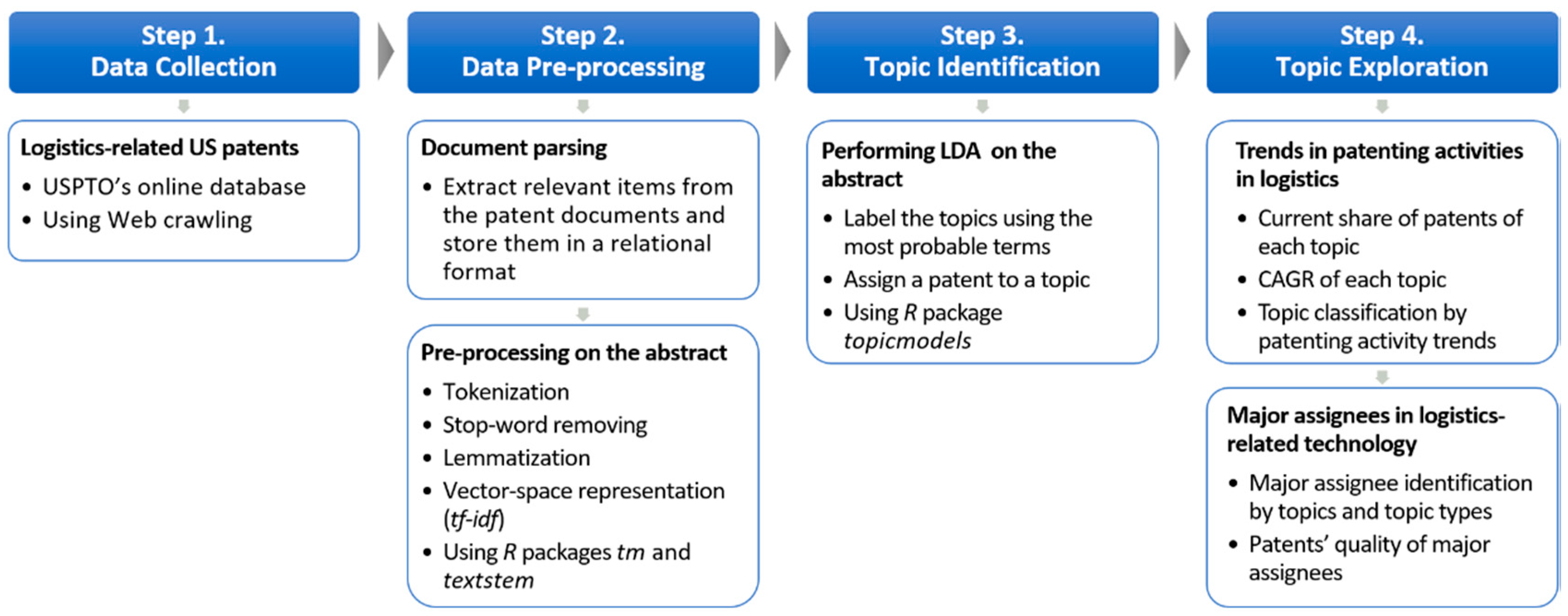
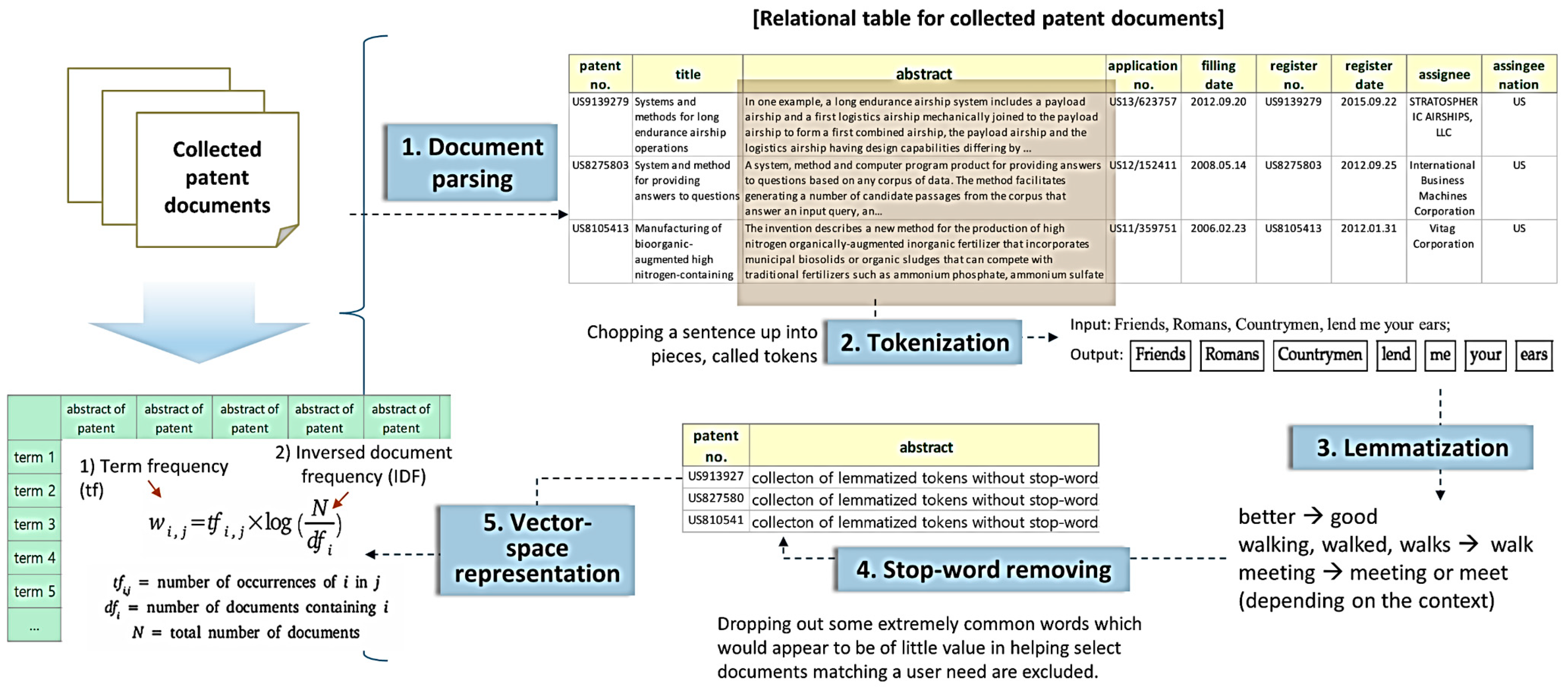
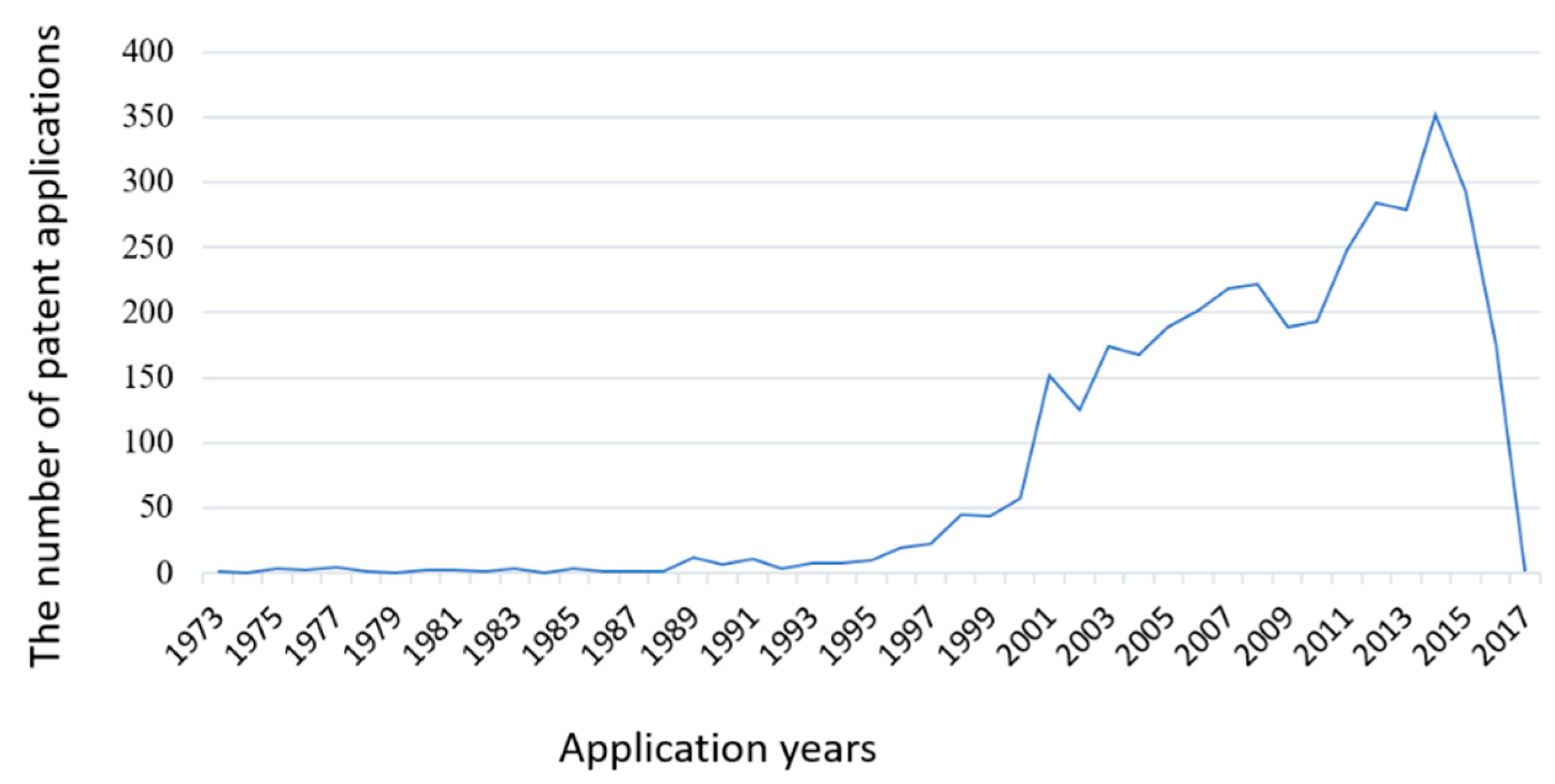

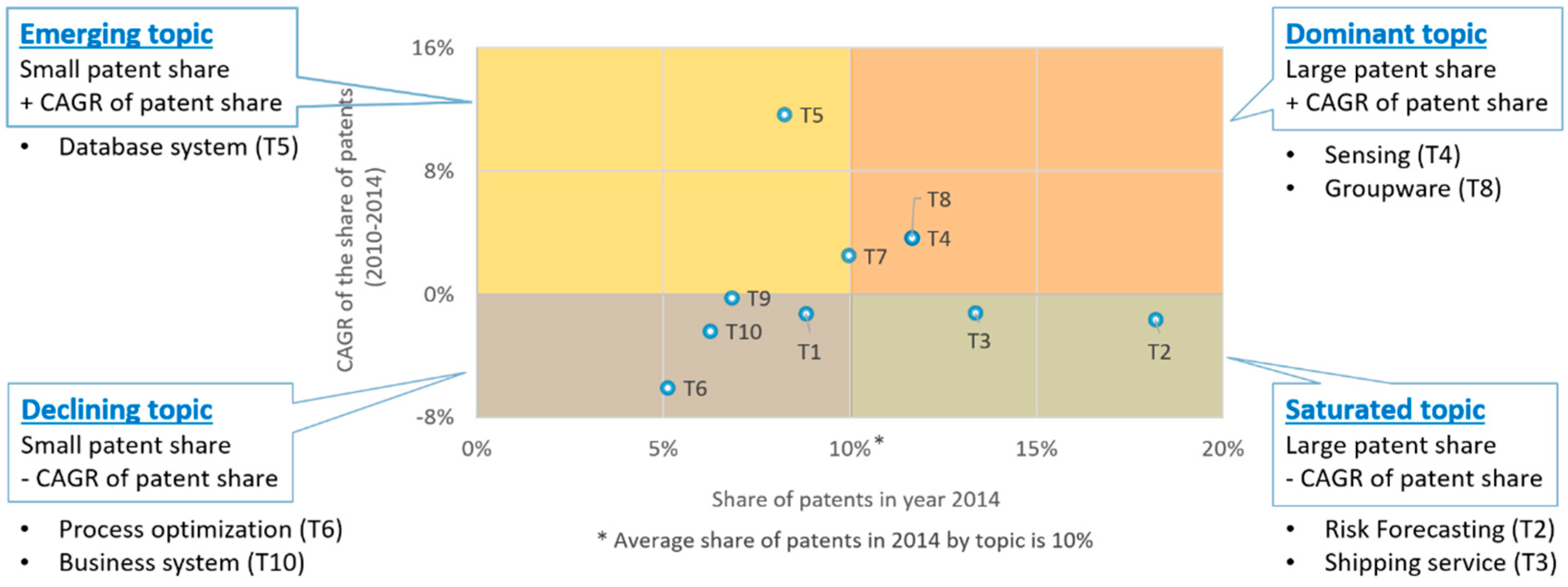
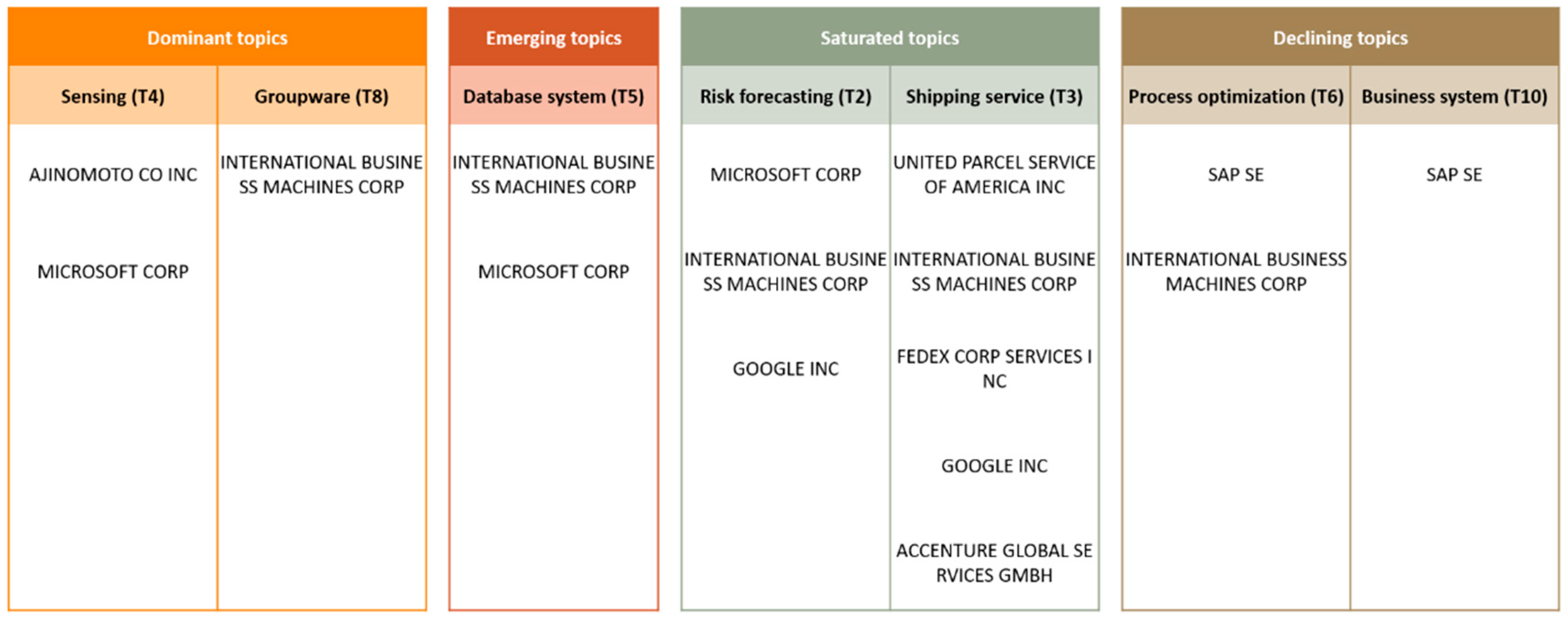
| Rank | Assignee | # of Patent Applications | Cumulative % |
|---|---|---|---|
| 1 | INTERNATIONAL BUSINESS MACHINES CORP | 130 | 3.5% |
| 2 | SAP SE | 75 | 5.5% |
| 3 | MICROSOFT CORP | 68 | 7.3% |
| 4 | GOOGLE INC | 44 | 8.5% |
| 5 | UNITED PARCEL SERVICE OF AMERICA INC | 41 | 9.6% |
| 6 | FEDEX CORP SERVICES INC | 32 | 10.5% |
| 7 | GENERAL ELECTRIC CO | 29 | 11.2% |
| 8 | XEROX CORP | 27 | 12.0% |
| 9 | ACCENTURE GLOBAL SERVICES GMBH | 25 | 12.6% |
| 10 | DEUTSCHE POST A G | 24 | 13.3% |
| 11 | YAHOO INC | 22 | 13.9% |
| 12 | BOEING CO | 21 | 14.4% |
| 12 | SIEMENS AG | 21 | 15.0% |
| 14 | AJINOMOTO CO INC | 17 | 15.4% |
| 14 | LOCKHEED MARTIN CORP | 17 | 15.9% |
| 14 | WAL MART STORES INC | 17 | 16.3% |
| 17 | AT&T INTELLECTUAL PROPERTY I LP | 16 | 16.8% |
| 18 | UNISYS CORP | 15 | 17.2% |
| 18 | WABASH NATIONAL CORP | 15 | 17.6% |
| 20 | ALIBABA GROUP HOLDING LTD | 14 | 18.0% |
| 20 | INDUSTRIAL TECHNOLOGY RESEARCH INSTITUTE TAIWAN | 14 | 18.3% |
| 22 | KONINKLIJKE PHILIPS NV | 13 | 18.7% |
| 22 | LINKEDIN CORP | 13 | 19.0% |
| 22 | UNITED STATES NAVY | 13 | 19.4% |
| 25 | CATERPILLAR INC | 12 | 19.7% |
| 25 | MICROSOFT TECHNOLOGY LICENSING LLC | 12 | 20.0% |
| 27 | CERNER INNOVATION INC | 11 | 20.3% |
| 27 | ELECTRONICS AND TELECOMMUNICATIONS RESEARCH INSTITUTE | 11 | 20.6% |
| 27 | STANFORD UNIVERSITY | 11 | 20.9% |
| 30 | AMAZON TECHNOLOGIES INC | 10 | 21.2% |
| 30 | ARROWSTREAM INC | 10 | 21.4% |
| 30 | HONEYWELL INTERNATIONAL INC | 10 | 21.7% |
| 30 | SAMSUNG ELECTRONICS CO LTD | 10 | 22.0% |
| Topic # | Most Likely Terms (Lemmatized) | Label |
|---|---|---|
| 1 | logistic, system, control, unit, communication, configure, vehicle, storage, operation, track | Vehicle communication |
| 2 | model, value, patient, risk, level, parameter, train, probability, predict, sample | Risk forecasting |
| 3 | order, service, item, customer, location, management, delivery, part, ship, inventory | Shipping service |
| 4 | present, determine, signal, individual, subject, measure, condition, detect, disclose, describe | Sensing |
| 5 | datum, associate, generate, andor, relate, event, analysis, source, compute, performance | Database system |
| 6 | process, component, module, form, material, cost, multiple, structure, support, member | Process optimization |
| 7 | less, network, comprise, store, supply, database, image, server, plan, chain | Supplier network |
| 8 | plurality, feature, select, identify, determine, input, score, result, function, group | Groupware |
| 9 | information, user, product, receive, application, interface, container, electronic, display, sensor | Container product information system |
| 10 | system, computer, time, embodiment, business, transaction, program, message, code, create | Business system |
| Topic | The Number of Patent Applications | Current Patent Share 1 | CAGR of Patent Share 2 |
|---|---|---|---|
| Vehicle communication (T1) | 474 | 12.76% | −1.27% |
| Risk forecasting (T2) | 602 | 16.13% | −1.61% |
| Shipping service (T3) | 413 | 12.03% | −1.19% |
| Sensing (T4) | 384 | 10.07% | 3.69% |
| Database system (T5) | 282 | 6.84% | 11.68% |
| Process optimization (T6) | 363 | 10.05% | −6.07% |
| Supplier network (T7) | 335 | 9.45% | 2.52% |
| Groupware (T8) | 303 | 7.09% | 3.69% |
| Container product information system (T9) | 305 | 8.19% | −0.21% |
| Business system (T10) | 263 | 7.37% | −2.39% |
| Topic | Major Assignees | Relative Technology Share | Ratio of Registered Patents | Technological Scope | International Scope | Forward Citation Frequency |
|---|---|---|---|---|---|---|
| Vehicle communication (T1) | 0.57 | 2.19 | 0.51 | 6.91 | ||
| SAP SE | 1.00 | 0.82 | 2.91 | 6.18 | 8.56 | |
| UNITED PARCEL SERVICE OF AMERICA INC | 0.82 | 0.78 | 2.56 | 13.44 | 5.29 | |
| ARROWSTREAM INC | 0.82 | 0.78 | 1.11 | 11.56 | 23.86 | |
| GENERAL ELECTRIC CO | 0.55 | 0.83 | 3.33 | 3.83 | 6.80 | |
| Risk forecasting (T2) | 0.21 | 1.93 | 0.45 | 5.92 | ||
| MICROSOFT CORP | 1.00 | 0.91 | 2.43 | 3.22 | 14.06 | |
| INTERNATIONAL BUSINESS MACHINES CORP | 0.78 | 0.44 | 2.33 | 1.94 | 7.00 | |
| GOOGLE INC | 0.57 | 0.77 | 2.85 | 3.38 | 10.00 | |
| Shipping service (T3) | 0.48 | 1.90 | 0.34 | 5.84 | ||
| UNITED PARCEL SERVICE OF AMERICA INC | 1.00 | 0.31 | 2.06 | 8.63 | 28.40 | |
| INTERNATIONAL BUSINESS MACHINES CORP | 0.94 | 0.47 | 2.27 | 2.53 | 25.43 | |
| FEDEX CORP SERVICES INC | 0.81 | 0.00 | 0.00 | 28.23 | 0.00 | |
| GOOGLE INC | 0.69 | 0.36 | 1.00 | 2.27 | 5.00 | |
| ACCENTURE GLOBAL SERVICES GMBH | 0.56 | 0.78 | 3.44 | 7.44 | 20.57 | |
| Sensing (T4) | 0.45 | 2.01 | 0.46 | 7.58 | ||
| AJINOMOTO CO INC | 1.00 | 0.31 | 1.56 | 5.81 | 2.00 | |
| MICROSOFT CORP | 0.63 | 0.70 | 2.80 | 2.70 | 4.00 | |
| Database system (T5) | 0.48 | 1.79 | 0.45 | 6.53 | ||
| INTERNATIONAL BUSINESS MACHINES CORP | 1.00 | 0.46 | 0.92 | 1.46 | 7.33 | |
| MICROSOFT CORP | 0.77 | 0.90 | 1.90 | 1.90 | 7.00 | |
| Process optimization (T6) | 0.59 | 2.49 | 0.53 | 10.51 | ||
| SAP SE | 1.00 | 0.81 | 2.62 | 1.33 | 18.75 | |
| INTERNATIONAL BUSINESS MACHINES CORP | 0.62 | 0.92 | 4.00 | 3.38 | 26.25 | |
| Supplier network (T7) | 0.58 | 2.19 | 0.47 | 11.94 | ||
| INTERNATIONAL BUSINESS MACHINES CORP | 1.00 | 0.67 | 3.08 | 2.67 | 45.43 | |
| DEUTSCHE POST A G | 0.50 | 0.00 | 1.00 | 3.00 | 0.00 | |
| UNISYS CORP | 0.50 | 0.00 | 0.00 | 1.00 | 0.00 | |
| Groupware (T8) | 0.44 | 1.69 | 0.45 | 7.73 | ||
| INTERNATIONAL BUSINESS MACHINES CORP | 1.00 | 0.56 | 1.78 | 4.81 | 21.44 | |
| Container product information system (T9) | 0.41 | 1.87 | 0.36 | 6.52 | ||
| INTERNATIONAL BUSINESS MACHINES CORP | 1.00 | 0.53 | 1.53 | 1.93 | 6.88 | |
| FEDEX CORP SERVICES INC | 0.87 | 0.31 | 0.62 | 9.00 | 10.75 | |
| SAP SE | 0.53 | 0.88 | 3.13 | 1.63 | 9.14 | |
| Business system (T10) | 0.41 | 1.91 | 0.39 | 13.81 | ||
| SAP SE | 1.00 | 0.68 | 1.79 | 2.00 | 22.75 |
© 2018 by the authors. Licensee MDPI, Basel, Switzerland. This article is an open access article distributed under the terms and conditions of the Creative Commons Attribution (CC BY) license (http://creativecommons.org/licenses/by/4.0/).
Share and Cite
Choi, D.; Song, B. Exploring Technological Trends in Logistics: Topic Modeling-Based Patent Analysis. Sustainability 2018, 10, 2810. https://doi.org/10.3390/su10082810
Choi D, Song B. Exploring Technological Trends in Logistics: Topic Modeling-Based Patent Analysis. Sustainability. 2018; 10(8):2810. https://doi.org/10.3390/su10082810
Chicago/Turabian StyleChoi, Donghyun, and Bomi Song. 2018. "Exploring Technological Trends in Logistics: Topic Modeling-Based Patent Analysis" Sustainability 10, no. 8: 2810. https://doi.org/10.3390/su10082810
APA StyleChoi, D., & Song, B. (2018). Exploring Technological Trends in Logistics: Topic Modeling-Based Patent Analysis. Sustainability, 10(8), 2810. https://doi.org/10.3390/su10082810





